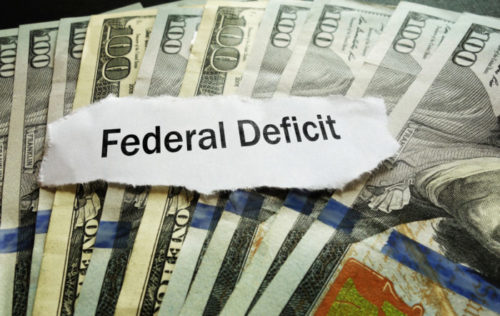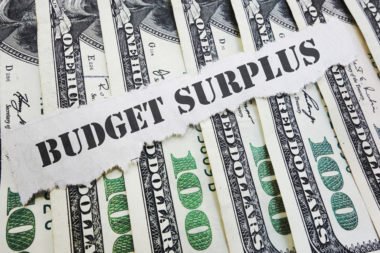A federal deficit occurs when a government spends more money than it takes in in revenue during a given year. The opposite of a deficit is a surplus. A surplus occurs when the federal government does not spend as much as it gets in revenue.
In the U.S., there have only been nine surplus years since 1950.
The national debt is the accumulation of each year’s deficit, minus any surplus. However, the sum of deficits does not match the overall national debt because the government can use funds from specific programs, such as the Social Security program, to lower the deficit without decreasing the debt.
As a result, the overall national debt in a given year is often larger than the deficit for that year.
In many instances, the deficit can have a positive short-term impact on the economy. For example, the government might not bring in as much revenue during a given year because they make tax cuts. The tax cuts lower the amount of revenue, but they also provide individual taxpayers and small businesses with more net income. This additional income can lead to more spending and hiring, which will help the economy in the short term.
Table of Contents
How Does a Federal Deficit Work?
The federal government creates budget deficits on purpose. There is usually a gap between the amount of revenue and the planned spending for the annual federal budget. The government bridges this gap by borrowing money. This borrowed money becomes the deficit, and, in the long run, it turns into the national debt.
The government borrows money from investors by selling bonds, known as Treasury bills. The U.S. Treasury issues these bonds, and the government also sells other securities.
Government spending can stimulate the economy in various ways, such as by offering tax breaks or funding infrastructure projects. Both the government and many taxpayers feel that running a deficit is a worthwhile tradeoff for a more robust economy. The Congressional Budget Office provides economic information to the legislature to help them make decisions about the feasibility and potential effectiveness of tax cuts or tax incentives.
What Causes a Federal Deficit?
The government can run a deficit for a variety of reasons. Most years, there is more than one type of spending that causes a deficit.
- Military spending can contribute to a federal deficit. When there are military operations abroad, such as recent deployments to Iraq and Afghanistan, defense spending increases so that the government can fund these operations. Defense spending has topped $6 trillion since the war on terror began in 2001.
- Tax cuts or stimulus payments can increase the annual deficit. The stimulus payments in early 2020 to provide economic relief during the coronavirus pandemic led to a budget deficit, and tax cuts for both businesses and individuals are the most common causes of a deficit.
- Welfare programs, Medicare, and Social Security programs are required spending. In other words, the government cannot cut these programs because they do not have revenue. Cutting them would leave millions without necessary social and medical services. Some benefits programs, such as Social Security and Medicare, get part of their funding from payroll taxes. However, these taxes do not cover the entire cost of the programs.
- Major infrastructure projects can also add to the deficit. In some cases, these are roads, bridges, or other infrastructure improvements that, Washington hopes, will lead to a more robust economy, provide additional jobs, or stimulate a flagging economy.
What Is Mandatory Spending?
Some spending gets mandated by law. The government has to fund entitlement programs such as Social Security and Medicare using this mandatory spending. The federal budget also includes mandatory spending for unemployment and welfare programs and monetary support to states for similar programs.
These programs get funded because laws or statutes require the government to finance them. The legislature cannot opt to cut these programs when making the annual budget, even if they cause a deficit.
In the cases of Social Security, Medicare, and Medicaid, payroll taxes provide some revenue. Social Security also has trust funds that cover some of the program costs. However, when the government is short on funds for these programs after getting the revenue from taxes and trust funds, it must borrow money, which contributes to the deficit.
The Importance of the Federal Deficit
The deficit can increase the national debt. However, it can have a positive impact on the economy and individuals’ finances.
The ability to have a deficit allows the government to keep taxes relatively low or lower than they would be without the ability to run a budget deficit.
When the country is in a recession or struggling economically, the government can increase its deficit and cut taxes for individuals. This step provides extra income for people that they can use to make ends meet during the economic crisis. Ideally, the additional spending will also help boost the country out of the recession by encouraging spending via tax cuts.
Taxes on individuals account for about half of all tax revenue. However, the government can also cut taxes for businesses to spur hiring and increase spending to counteract an economic recession and rising unemployment rates. Even if unemployment is low, employers can use low tax rates to pass benefits on to their employees.
These moves would not be possible without the ability to run a deficit. The government would be severely limited if they were only able to use existing revenue to respond to economic downturns. An extended economic decline could lead to more unemployment and less income, which could decrease tax revenue and make the federal budget even more modest in subsequent years.
Therefore, the deficit is a vital component of U.S. fiscal policy.
Advantages of the Federal Deficit
There are multiple advantages associated with the federal deficit:
- The deficit can push economic growth. During a recession, or perhaps to avoid an economic downturn, the government can borrow money via bonds and securities to cover tax cuts, infrastructure projects, and business-friendly programs. These moves can, ideally, help the economy.
- Taxpayers can still enjoy government services without having to pay a high tax rate. In practice, taxpayers usually support a federal deficit because it means lower or static tax rates. Consumers can have more income for spending or
- It allows for emergency spending. If the country decides that military action is necessary, for example, it can operate at a deficit to fund the military deployments. The government can also use the deficit when funding the response to a natural disaster.
Disadvantages of the Federal Deficit
Most of the disadvantages of the federal deficit have to do with the long-term impact of running a deficit.
- Some economists believe that while a federal deficit can bring short term benefits, it can hurt the economy in the long run. An annual deficit could distort interest rates and could lead to inflation because the government is releasing extra money into the economy.
- Since the government will eventually have to pay off the debt, the deficit would result in much higher tax rates in the future.
- Foreign investors and countries can purchase government bonds, which could give them influence over the U.S. economy.
- In the long term, the government may need to resort to austerity measures, such as cutting benefits and social services, to balance the budget. The U.S. rarely resorts to such measures, but they have been very unpopular in other countries.
How Much Is the U.S. Deficit?
The deficit for a given year fluctuates from month to month. According to a report in Reuters, the deficit for 2020 will be $3.8 trillion. This number is relatively high because it includes tax breaks and stimulus money meant to deal with the economic fallout from the coronavirus pandemic.
The report projects a $2.1 trillion deficit for 2021 and an average of $1.3 trillion for each subsequent year through 2025.
These deficits are more than in previous years when the economy was in relatively good condition. At the end of the 2016 fiscal year, for example, the deficit was at $586 billion.
Image Source: https://depositphotos.com/





